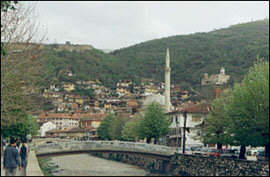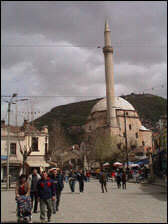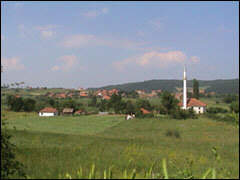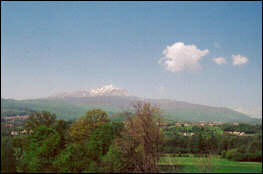 ALL PLACES OF INTEREST ALL PLACES OF INTEREST |
 Prizren and the Sar Mountain region Prizren and the Sar Mountain region |

Prizren Town Bridge
Prizren has a population of 80.000 inhabitants. This is one of Kosovo's greatest historic sites. A wealthy and antique city dating back to the Ottoman period it is a true open-air museum with many attractions to see. It is situated in the South of the Dugagjin territory and the hills above Prizren form a natural fortress dominating the Jealenice plain. There is an Illyrian town called Theranda, which was inhabited by the ancient Dardanian tribe that grew up around the fortress in the early classical period and became an urban center after the Roman conquest.
 The Mosque of Sinan Pasha and Ottoman Prizren The Mosque of Sinan Pasha and Ottoman Prizren |
The great architect Sinan built the Mosque, and it is worth seeing it with its gentle mournful atmosphere and intricate flower and leaf tracery designs on the walls and its high small windows. Part of the portico has been lost, as can be seen from masonry marks on the external wall facing the river.

Mosque of Sinan Pasha
 The Hammam The Hammam |
Is a very large structure with several small domes, it is in a fairly good condition but is in need of urgent renovation. Most of what you see dates from the 18C, when the earliest baths were rebuilt.
 The Fortress The Fortress |
The walk up to the castle takes about an hour. It is through streets, which used to be the main quarter of Prizren. Walk up the hill by an alleyway, which winds in and out of small streets with many picturesque domestic scenes and small traditional gardens with vines, fruits and vegetables. The outer walls of the castle which are in a short distance above the old church under KFOR guide, are in good condition, but there are little remains of the internal buildings.
 Dragash Dragash |
Is a region to the Southwest of Prizren. It consists of thirty-six villages and it is a hilly area with very poor roads except for the main road up to Prizren, which was modernized in 1991-92. In many places traveling by donkey or by horse is preferable to any driven vehicle. On leaving Prizren and 10km away and on the way to Albania, you reach the little town of Zhur, which was devastated in the recent war but there are still few traditional houses with carved woodwork doors and painted decorations using solar motifs around the window frames. In winter the Gora hills are unreachable, except by helicopter, with the North facing Sar range that has a particularly harsh climate. About one third of the population are Gorani Slav -speaking Muslims, the remainder Albanians, and ethnic Turks. The Albanians nearly all live in the northeast region called Opoja.
 Gjakova Gjakova |

On the road to Gjakova
Gjakova has a population of 75.000 and it is the main town of central Dukagjin, and a historic urban settlement with a remarkable complex of Ottoman buildings and a long history. It was a small market town of Byzantine and the medieval period, but it grew into a significant Ottoman town in the later Empire. In the late 19C Gjakova had a growing Albanian middle class and was a nationalist struggle after the foundation of the League of Prizren. Yugoslav governments had problems with most of the population never accepting that their home town should be within Yugoslavia, and the region was a center of resistance to Royalist rule before the Second World War, and the Titoist communist Dictatorship.
| The liberation war and the Kosovo Liberation Army found strong support and Juniku the largest village in Kosova had to deal with the first offensive against KLA and the Yugoslav Army destroyed the ottoman castles in Upper Junik in 1988.
The Serb offensive later in 1998 and 1999 resulted in the destruction and lying waste of much of the commercial area and Ottoman market. That is why here is urgent restoration and rebuilding of the historic treasures is required.
 The Carsije Quarter The Carsije Quarter |
The Carsije or the Old Market Quarter, is in ruins on the whole, the 15 Century Mosque of Hadim and its minaret which was once an attraction for travelers that came from Albania. There is a reconstruction planned from the Saudi Arabian Foundation. Nevertheless some part of some streets survived and the locals expect the visitors with pleasure.
 PEJA PEJA |

Approach to Peja
Peja is Situated at the foot of the Damned Mountains (Bjeshk't e Nemuna) and on the river Bistrica at the entrance of the Rugova Gorge. It is a town with approximately 85,000-90,000 inhabitants and is considered to be the main economic and cultural center of the Dukagjin region of Kosovo. It location is amidst one of the most beautiful regions in Kosovo while its rich urban architecture dates from the Turkish period. Some of the towns most prominent features are The Sheremet Tower, also known as a Dukagjin tower and also the attractive Bajrakli mosque which dates from the 15th Century and is considered to be one of the oldest Islamic architectural structures in Kosovo.
 GJILANE GJILANE |
Gjilane is the main town in southeast Kosovo, from a visitor point of view it is one of the least attractive cities in Kosovo but as the municipal center of the region it has administrative and political importance. Historically there is little to see. If you are passing through, it is recommendable to take some time to visit the outstanding Gracanica Church, the monument itself is located 12 km outside of Gjilane on the road towards Prishtina and was built by King Milutin of Serbia in 1312. The church is quite unique and within its walls there is a wonderful display of Serbian medieval art, which is referred to as Frescos. The other fine feature of the town is the remains of the Medieval Fortress at Novo Brdo. Which is dramatically positioned medieval castle, again situated just a little outside the town, the best time to visit Novo Brdo is during the spring or summer months when the forests surrounding the Fortress come alive with color and the scent of flowers.
 MITROVICA MITROVICA |
Historically is one of the most important economic centres in Kosovo. The main reasons behind this status are due to the location of the Trepca mining complex that in 1997 was estimated to have contributed more then $100 million per annum to the Yugoslav national budget. The town of Mitrovica has a long and complicated mining and political history, since the conflict in 1999 there remains a north-south, Serbian-Albanian ethnic divide across the town, which now falls under the supervision and protection of the French KFOR. At present there is no official hotel for visitors to stay at and day visitors although welcome, are recommended be careful in this area. Passports and identity documents are important to carry with you at all times and although it is still possible to visit historical sites of interest schedule your visit in the daytime and with a qualified guide.
 Ottoman Hammam: The Hamman of Mitrovica Ottoman Hammam: The Hamman of Mitrovica |
Mitrovica is a modern town and historical monuments are few and far between. The town baths represent the most interesting historical feature, which were originally built in the C18th and also served as the town museum for many years. At present it is not possible to enter inside the building although should the opportunity arise you will find a delightful entrance hall with a centrally featured fountain. As you proceed into the building you will come across Romanesque arches displayed on the walls that decorate the reception hall leading to the four bathing rooms. |

